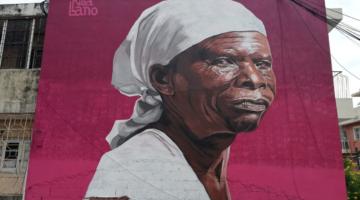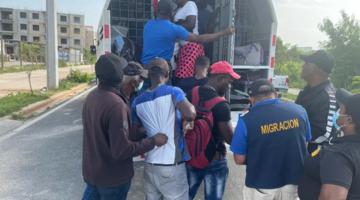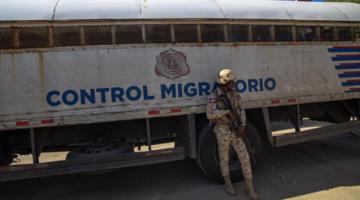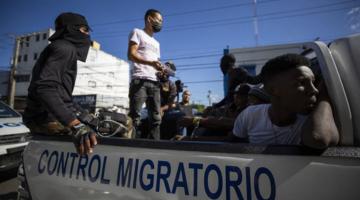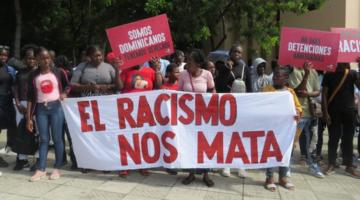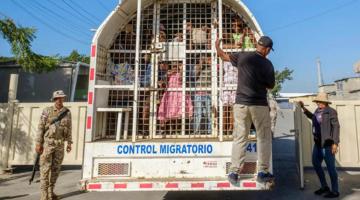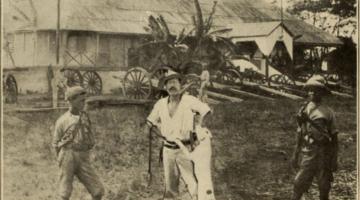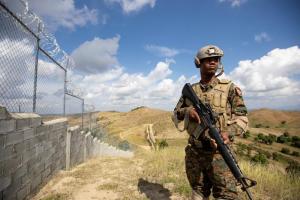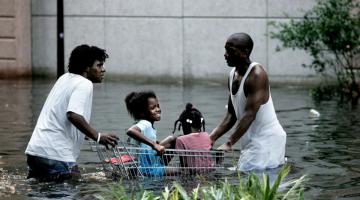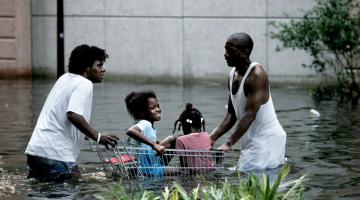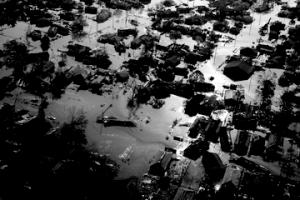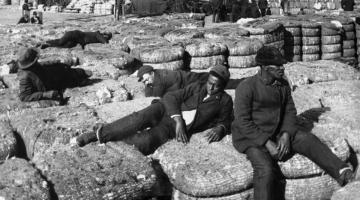Dominican author Sorayda Peguero Isaac on the persistence of anti-Haitianism.
According to the Dominican Republic’s Dirección General de Migración, between January and October of this year, 386,925 Haitians have been forced to leave the country through a combination of deportation, repatriation, and “voluntary return.” It is a staggering number – 386,925 – and a figure that will only increase exponentially following Dominican President Luis Abinader’s recent and racist pledge to remove 10,000 Haitian people a week from the country. This wave of deportations comes after a quarter of a million Dominicans of Haitian descent were stripped of their citizenship and made stateless in 2013.
Abinader has stated that the question of Haitian migration is a question of Dominican “sovereignty.” He has argued that, until the international military occupation stabilizes Haiti, the Dominican government has the sovereign right to defend its borders and control the movement of populations into and out of the country. Yet sovereignty is a fraught, contradictory, hypocritical term when it comes to the Dominican Republic and Haiti. The Dominican economy, a pillar of Dominican sovereignty, is partly dependent on a cheap, irregular labor pool of Haitian workers; there is a reason why even as the Dominican state is removing Haitian workers, Dominican businesses continue to smuggle Haitian workers in. There is also the other side of the Dominican economy: it depends on Haiti for a large share of its export market.
Moreover, if for racist ultra-nationalists like Abinader, sovereignty is based on an idea of blood and soil, both, in the Dominican case, are impure, tainted by the hated trace of Africa that the Dominican state has long sought to repress and remove. Africa is the reason for the creation of the Dominican national cult of Quisqueya, with its embrace of an indigenous origin for Dominican racial identity; Africa is the reason for the racist ideology of anti-Haitianism that has led to repeated flashes of exterminationist state violence against Haitians and their descendants living in, or near, the Dominican Republic. Abinader’s recent deportation policy is but the latest example of such anti-Haitian violence. Though invoked in the name of sovereignty, his policy is based on a foundation of racism.
Historically, the worst example of this anti-Haitian violence in the name of Dominican sovereignty occurred in 1937. From 2 October 1937 to 8 October 1937, between 14,000 and 40,000 Haitian people and Dominicans of Haitian descent, peasants and migrant workers living in the frontier zone separating Haiti and the Dominican Republic, were slaughtered. What was the cause of this massacre? As the journalist, columnist, and author Soryada Peguero Isaac wrote: “One day back in 1937, the dictator Rafael Trujillo declared that all the Haitians living in Dominican territory should be exterminated.” The massacre was carried out by both local police and, in many cases, local peasants and former prisoners who were forced to participate. Haitian men, women, and children were rounded up, herded together, and butchered with machetes and three-pronged knives. Their bodies were sometimes buried, sometimes burnt, sometimes thrown into the Dajabon River (also called the Massacre River). This carnage was later called the Parsley Massacre because, comments Peguero Isaac, “as much as some people want to deny it – and believe me, there are many such people – it is nearly impossible to tell …Dominicans and Haitians apart.” Thus, the victims were identified as Haitian by their inability to pronounce the Spanish word perejil, for parsley. The bitter irony of the massacre is that many Dominicans of Haitian descent and other Black Dominicans, indistinguishable from their Haitian brothers and sisters, were counted among the dead.
How many of the 386,925 Haitians who have been deported in the last year were Dominican?
In 2021, Peguero Isaac published an essay exploring the memory of the 1937 massacre titled “The Peril of Mispronouncing ‘Parsley.’” Born and raised in the Dominican Republic but based in Barcelona, Peguero Isaac’s essay examines the questions of race, identity, violence, and sovereignty behind the Parsley Massacre. In light of the current anti-Haitian frenzy being fomented by Abinader and the racist Dominican elite, her essay also shows us how close we are – or can be – to yet another attempted extermination of Haitians and Black Dominicans.
Soryada Peguero Isaac’s “The Peril of Mispronouncing ‘Parsley’” was first published in the journal Plough, translated from the Spanish by Coretta Thomson. We reprint it below.
The Peril of Mispronouncing “Parsley”
Sorayda Peguero Isaac
Every Friday at the very end of the afternoon, Ms. Magdaliza held an informal talent show. The bravest students sang songs or recited poetry. One Friday, Marta, who was sitting right in front of me sucking on a grape lollipop, whirled around to tell me she was going to sing a ballad that had brought her aunt Mildred to tears. Her tongue was all purple. When it was her turn, she wrapped the lollipop in a page she’d torn from her Social Studies notebook, smoothed the pleats of her skirt and straightened the silk headband she always wore on Fridays. Marta had all colors of headbands: a different one for every day. Her skin was blueish-black. Her eyes were also black and large as two full moons.
Willie Portorreal, another student, always emceed. He stood in front of the chalkboard holding a cardboard microphone and, with a voice that seemed to imitate a sports announcer, presented Marta as “the great Haitian star.” There was an outburst of laughter: wild laughter, timid laughter, nervous laughter, laughter that crashed mercilessly over Marta’s head. The poor girl. She sank back down into her seat and hid her face in her hands. From my place, I could see her shoulders heaving up and down with her sobs. Marta was not Haitian. Nor did she want to be. Not one child in La Anacahuita school, in the town of Haina on the outskirts of Santo Domingo, wished to bear such a cross.
Out in the yard at recess, we had found a new way to pass the time: seeing who mispronounced the word perejil, or “parsley.” The interrogees stood in the middle of the circle of children.
“Say perejil.”
“I didn’t hear you.”
“Say it again.”
“You have three chances.”
“Here’s a pití gasón!” A Haitian boy.
Often, at least one child fled these “say parsley” games in tears. Then Pedrito Maldonado Pérez’s mother strode into the director’s office one afternoon with the birth certificates of various family members. Her son had stayed home from school for two days, saying he didn’t want to go. She told the director that there were no Haitians in either the Maldonado or the Pérez families, and if her son Pedrito had problems saying perejil, it was because he stuttered.
We had found the perfect place to play our game. It was right at the edge of the schoolyard, hidden from passersby by the bougainvillea vine that twined through the metal fence. But it didn’t prevent their hearing us. Doña Pepé, a woman who lived nearby and sold fruit juice at the front gate every Tuesday and Thursday, was eavesdropping on us one afternoon.
“I’d like to know who started this game,” she called. “Don’t they teach history in school anymore?”
One day back in 1937, the dictator Rafael Trujillo declared that all the Haitians living in Dominican territory should be exterminated. As much as some people want to deny it – and believe me, there are many such people – it is nearly impossible to tell us Dominicans and Haitians apart. There are many reasons that can be summarized in one word: Africa. It’s so simple that Trujillo, who used to whiten his face with rice powder, had to think up a way to carry out his extermination plan. In Haitian Creole, the r sound is pronounced differently than in Dominican Spanish. So to discern who to kill, the dictator’s soldiers asked their potential victims to say the word perejil. No one knows how many Haitians were murdered on the Haiti–Dominican Republic border. Some say hundreds and others, thousands. I once heard my grandfather say that at the time of the Parsley Massacre, the Dajabón River, separating the two countries on the island of Hispaniola, ran red.
When I asked what perejil was, they told me of an herb used in cooking. I had never seen it. I knew of celery and cilantro: those green, aromatic branches that towered over grocery store counters and were added to bean dishes and beef stew. I couldn’t even find a photo of the famous perejil in my science book. Could it be that Trujillo had had all the perejil in the Dominican Republic pulled up? I imagined an army of uniformed men in khaki shirts and pants, tall boots and straw hats, armed with knives and machetes of different sizes, yanking out parsley plants as if there were no tomorrow.
Antonia, the woman who helped my mom around the house, told me that perejil also chased away evil. I wondered what evil looked like. Was it a solid, liquid, or gas? Did it jump across time like the stilts of a long-legged zancudo from the carnival parade? Was it black as shoe polish or white as milk, large as a calabash or small as an anise seed?
We had learned that the Haitians were blacker than us: blacker and poorer. Their names were not like ours.
I knew that Marta had a Haitian grandfather. She once told me that Odilión Jean, whom she called papá, had left Haiti to work in a sugar cane field in San Pedro de Macorís, a town just east of Haina. There he married a Dominican woman. Marta’s father and his five siblings arrived. That is why Marta’s first surname was Jean. And that is why when Ms. Magdaliza called our names as she took attendance, even before Marta could say “here,” snickering murmurs ran around the room. We had learned that the Haitians were blacker than us: blacker and poorer. Their names were not like ours. Even the smell of the sweat that gleamed on their skin was different than ours: more fetid. And those voodoo ceremonies where they drank animals’ blood and chewed children’s bones weren’t the half of it. The worst was that a Haitian could turn into a zombie, take you over, and condemn you to a life of eternal bondage.
Marta told me that Odilión Jean always had the same dream and told it time and again at every family gathering, as far back as Marta could remember. He dreamed that an army of red ants lifted him off his wicker mat (after so many years of sleeping in a refinery hut, Odilión Jean refused to sleep in a real bed). The ants, who knew exactly which way to go, passed through the heart of the cane field, where Odilión Jean breathed the sweet smell of sugar cane and listened to the rustling of the leaves as they trembled in the soft night wind. The ants advanced, carrying him on their backs. When they crossed the Dajabón River, the old man stretched out his calloused hand to trail his fingers in the water. The next morning, Marta’s grandfather awoke on his native soil.
Marta stopped talking with everyone after Willie Portorreal made his joke at her expense, though in our school such teasing was common. She sat silently in her seat, her eyes fixed on the infinite. She was giving us the silent treatment, the so-called “law of ice” we’d learned from watching the Mexican telenovela Carrusel. In the series, the one who got punished was an annoying blonde who despised the only black boy in Ms. Ximena’s class. Marta wasn’t the only black girl in Ms. Magdaliza’s class. We were all black, but she was the only one with a name that weighed on her like a concrete house.
At one time I worried that my second surname would arouse suspicion. The only people in the whole school with the surname Isaac were my two sisters and me. So I wanted to be prepared and know what to say if things got complicated. My maternal grandfather, now deceased, had brought the name to the island from an English colony in the Lesser Antilles. I imagined that, if my heritage landed up in the crosshairs and the kids started making fun of me, Marta and I would share more than jokes and tear-jerking songs.
I didn’t know how to take her silence. I thought of writing a letter asking her why she had stopped talking to me, knowing – as she surely did – that I would always be on her side. Our friendship was unconditional, after all, and if I had said anything to Willie I would only have made things worse for her. To my surprise, Marta took the first step. In one of my backpack pockets I found a paper folded in half, written in a neat cursive like a Palmer handwriting sample: “I’m not mad at you but I don’t want to stay in this freaking school. Hope they pull me out. Are they going to sign you up for ballet? They’re going to start this course on Sunday mornings. My mom says I can go if your mom says you can.”
They were going to start a ballet class for girls aged six to twelve at the Living Waters Community Center. The course director was visiting all the houses in the neighborhood and talking to the parents of potential students. She was a tall, big-hipped, red-headed woman, Dominican like the rest of us. When she came to our house one Saturday morning just before noon, mom changed out of the bathrobe she used inside the house, put on a blue dress and a few drops of Gloria Vanderbilt perfume, and told Antonia to watch the stew that was boiling in the big pot.
Classes would start at 9:30 on Sundays. The course director would come by to accompany the girls who lived on the other side of the highway from the center. The next day, I waited with my face glued to the bars of the gate. I felt my heart leaping with a strange joy that swam in my stomach like a betta fish. When I saw the director turn into my street, flanked by two girls that looked like sisters, I let mom know so she would come out to open the gate. The director greeted her and said to the two girls and me, “Let’s go, my daughters.”
Before entering the practice room in the Living Waters Community Center, everyone had to file past a counter. There sat the director, verifying our personal information and writing who-knows-what in the registry book. Marta had saved me a place behind her. When the director queried her name and age, Marta replied that her surnames were Jiménez Brea. The director looked up from her book, wrinkled her brow, and removed the cap of her pen with her teeth.
“Jiménez?”
“Yes, with a J and an accent mark on the first e.”
“Girl, I know very well how to spell it. But tell me something: Isn’t your first surname Jean?”
“No, no, no. – My paternal surname is Jiménez. My full name is Marta Jiménez Brea. I am nine years old and will be ten in August.”
“So it looks like we got it wrong here.”
“Yes, it must have been a mistake.”
From the expression on Marta’s face, I imagined she had practiced her act all night, repeating her new name until it stuck to her tongue, writing “Jiménez,” with a J and an accent mark on the first e until sleep overcame her, until her pencil wore out, or until her mom told her to go to bed, that it was enough now.
Before turning to me, the director put the book down on the counter and looked for a bottle of white correction liquid. I couldn’t help thinking that if you scratch whiteout with your nails, the original word appears again, just like an herb plant puts up new shoots if its roots are left in the earth.
Soryada Peguero Isaac, “The Peril of Mispronouncing ‘Parsley’” Plough (December 31, 2021).

